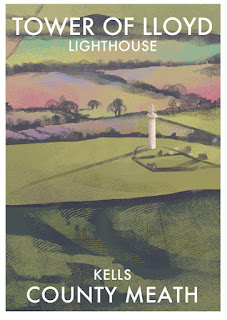In March 1846 a request was submitted that lighthouses be established on Bull Rock, Galley Head to the west of Kinsale Old Head, and on the Foze Rocks off the Blasket Islands. Galley Head was approved but the Bull and Foze Rocks were postponed and ultimately Calf Rock (of Calf, Cow and Bull rocks) was chosen as the site for the lighthouse. The tower was completed in August 1864. The lantern, optic and revolving machinery were added the following year making the tower 121 feet high. The light was established on 30 June 1866, 136 feet above high water.
A severe storm early in 1869 washed away a section of the lantern balcony rail and a hut containing stores. The Keeper ashore thought he saw distress flags on the rock so with six boatmen braved the stormy seas only to find the Keepers on the rock were safe and sound. When the boat turned to return to the main land it was caught by the sea and capsized, all hands were lost.
On 27 November 1881 the lighthouse was destroyed by a violent storm, the tower complete with lantern snapped off above the strengthened base and fell into the sea. Fortunately neither the Keepers nor the three other men were in the tower and all six were taken off the rock two weeks later by the boat attendant helped by HMS Seahorse.
With Calf Rock damaged beyond repair thoughts turned back twenty years to Bull Rock being the most suitable of the three rocks. In February 1882 the Inspecting Committee of the Commissioners of Irish Lights recommended Bull Rock to Trinity House.
Bull Rock is notable for the natural tunnel running right through it. It is situated off the entrance to Kenmare River, five-and-a-half miles from the mainland and two-and-a-half miles from the nearest point of Dursey Island. The station was completed in 1888 and on 1 January 1889 Bull Rock's light and fog signal were established.
The light was converted to electric power on the 21 August 1974 and on 31st March 1991 the lighthouse was converted to automatic operation and the Keepers were withdrawn from the station.
This is one of just over sixty coastal lighthouses and many more harbour and estuary lights I've illustrated. I'll be posting them up each day.
The A2 poster of 16 of the most iconic lighthouses is up and ready to ship. If you're interested in a particular lighthouse they're available in A4 or A3 size.
www.irelandposters.ie





































